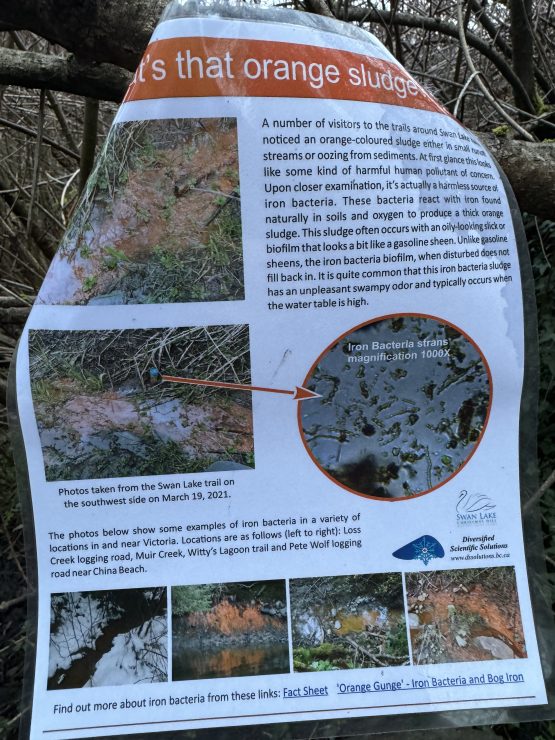This hidden gem has overcome plenty of adversities

Photo by Atum Beckett.
If you’ve walked around Saanich’s Swan Lake nature sanctuary recently, you probably noticed the large floating cylinders around one half of the lake. These were put in place after approximately 600 liters of heating oil leaked out of a nearby residential property in late January. While there have been no reported effects on the local wildlife, these preventative measures remain in place.
“The spilled material appears to have been limited to a marshy area adjacent to the spill site and did not enter the main part of the lake,” reads a government update on the situation. No official updates have been released since early February.
A similar incident occurred in Esquimalt just 10 days prior to the spill at Swan Lake. An oily substance was detected at the Gorge Waterway on Jan. 19, and the source was confirmed to be a home oil tank which has since been contained.
The township of Esquimalt says that “there are no reports of any harm to wildlife or other significant negative effects.”
Still shaken up by the oil spill, I noticed an orange sludge with an oily sheen can be seen in several places around the trail in the marshland. I got closer to examine what was surely another disaster, but only saw a sign.
It explained that this is a natural occurrence, not something caused by the oil leak.
“At first glance this looks like some kind of harmful human pollutant of concern,” it reads. “Upon closer examination, it’s actually a harmless source of iron bacteria.” I’ve noticed this same phenomenon at Swan Lake in past years.
In light of the recent spill, and my presumption that a natural occurrence was further pollution, I decided to educate myself on the history of Swan Lake, whose natural beauty is easy to take for granted.
The lake is no stranger to harmful pollutants. Swan Lake used to be much larger according to maps from the 1800s. It shrunk as a byproduct of eutrophication, the process of nutrient and sediment accumulation in a lake that is characterized by excessive plant growth and algal blooms.
Rapid urban development in Victoria meant that fertilizer runoff from surrounding farms, waste from the nearby sewage treatment centre, and sludge from local wineries were disposed of into Swan Lake. This greatly increased the rate of eutrophication.
What was once an important hunting ground for the Songhees people became a dumping ground for the booming Capital Regional District. This waste being pumped in caused the lake to become smaller and to have huge blooms of algae and plankton, disrupting the natural ecosystem. Cyanobacteria can still reach levels that are dangerous to human and aquatic health in the warmer months.
In the 60s, the municipality of Saanich started acquiring around Swan Lake and the nearby Christmas Hill in order to preserve the area’s natural beauty.
Then, in 1975, the Swan Lake Christmas Hill Nature Sanctuary Society was officially formed. Many educational programs are offered through the Sanctuary Society, and the Nature House interpretive information center on the edge of the lake is a great place to learn about the area while on a walk.
Restoration efforts began in recent years to help the salmon population return to the Colquitz river, which Swan Lake runs into. And earlier this year, Swan Lake received grant funding to not only improve its waterways for salmon, but to also increase community engagement.
Finally, Swan Lake helped Saanich become certified as a bird friendly city, a program through Nature Canada created to help address the decline in bird populations in North America.
The more I started to learn about Swan Lake and the surrounding nature, the more I realized how little I know about this place I call home. I was pleasantly surprised by just how much information there is available on it. James G. Swan, who Swan Lake may be named after, wrote extensive journals chronicling his time here in the 1800s.
While it can be uncomfortable reading recounts from colonizers, learning and understanding the history of the area has helped me appreciate all the work that has been done to help preserve our priceless natural beauty.








